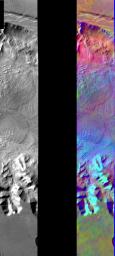
|
Melas Chasma in IR Color
- Click the image above for a larger view
- Full-Res JPEG (900 x 2013) (205.2 kB)
- Full-Res TIFF (900 x 2013) (3.4 MB)
Caption:
Released August 11, 2004This image shows two representations of the same infra-red image over Melas Chasma. On the left is a grayscale image showing surface temperature, and on the right is a false-color composite made from 3 individual THEMIS bands. The false-color image is colorized using a technique called decorrelation stretch (DCS), which emphasizes the spectral differences between the bands to highlight compositional variations.
There is a distinct purple/blue layer present in the northern wall of the Chasma. Although this layer likely has a composition different than the surrounding areas, it is difficult to interpret its specific composition due to the high variability of sunlit and shaded surfaces in this area, which cause a wide range of temperatures to be present within each pixel of the image. It is possible that this layer has a unique composition due to differences in the volcanic or sedimentary environment at the time that the rock formed, or it could be a layer of magma injected between two previously existing rock layers. Another possibility is that the wall is mostly covered by dust and debris, and this portion contains the only exposed bedrock. The light blue colors present in many other areas of the Chasma are due to water ice clouds.
Image information: IR instrument. Latitude -8.9, Longitude 282 East (78 West). 100 meter/pixel resolution.
Note: this THEMIS visual image has not been radiometrically nor geometrically calibrated for this preliminary release. An empirical correction has been performed to remove instrumental effects. A linear shift has been applied in the cross-track and down-track direction to approximate spacecraft and planetary motion. Fully calibrated and geometrically projected images will be released through the Planetary Data System in accordance with Project policies at a later time.
Background Info:
NASA's Jet Propulsion Laboratory manages the 2001 Mars Odyssey mission for NASA's Office of Space Science, Washington, D.C. The Thermal Emission Imaging System (THEMIS) was developed by Arizona State University, Tempe, in collaboration with Raytheon Santa Barbara Remote Sensing. The THEMIS investigation is led by Dr. Philip Christensen at Arizona State University. Lockheed Martin Astronautics, Denver, is the prime contractor for the Odyssey project, and developed and built the orbiter. Mission operations are conducted jointly from Lockheed Martin and from JPL, a division of the California Institute of Technology in Pasadena.
Cataloging Keywords:
| Name | Value | Additional Values |
|---|---|---|
| Target | Mars | |
| System | ||
| Target Type | Planet | |
| Mission | 2001 Mars Odyssey | |
| Instrument Host | Mars Odyssey | |
| Host Type | Orbiter | |
| Instrument | Thermal Emission Imaging System (THEMIS) | |
| Detector | ||
| Extra Keywords | Color, Dust, Infrared, Thermal, Volcano, Water | |
| Acquisition Date | ||
| Release Date | 2004-08-11 | |
| Date in Caption | ||
| Image Credit | NASA/JPL/Arizona State University | |
| Source | photojournal.jpl.nasa.gov/catalog/PIA06820 | |
| Identifier | PIA06820 | |
